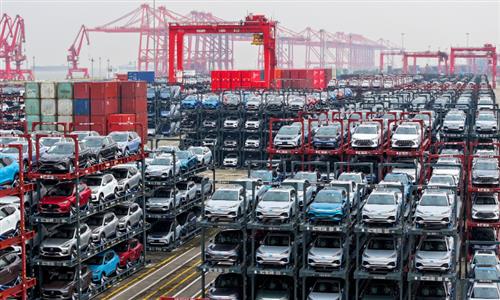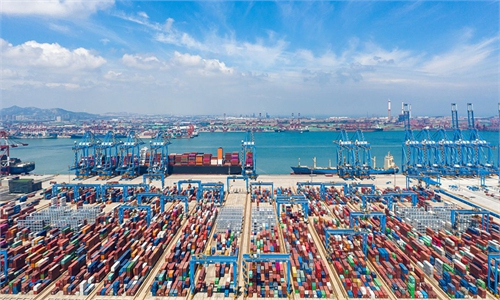

A view of the skyline of Beijing's CBD area. Photo: VCG
"The engine of global economic growth" and "the main contributor to global economic growth" are terms often mentioned by overseas media and observers when discussing the Chinese economy.In the past decade, China's contribution to global economic growth exceeded the Group of Seven (G7) developed economies. In 2023, facing the challenges of a slow post-pandemic recovery and a turbulent international environment, China contributed 32 percent of global economic growth, with its own GDP expanding by 5.2 percent from a year earlier.
For a long time, one of the important reasons why the Chinese economy has been able to withstand risks and overcome numerous difficulties, both internally and externally, is a deep understanding and grasp of economic laws, scientific thinking and exploration of ways to change development patterns, more efforts in exploring new development drivers, and a firm determination and action in economic structure reform.
First, China's economy has been supported by exploring new growth drivers in line with new economic trends.
Some observers have argued that China's economic growth relies too much on public investment, and its technological innovation cannot be achieved without imitation. However, the fact is that in recent years, the promotion of consumption and expansion of domestic demand has been given unprecedented importance in the country's overall policy directions.
Since 2018, China has placed a strong emphasis on exploring the benefits of its vast domestic market. The country has actively worked to cultivate its comprehensive domestic demand, speeding up the smooth circulation of the entire supply chain. As a result, consumption has increasingly become the primary driver of economic growth, reaching a historic contribution level of 82.5 percent in 2023.
China's consumption power should not be underestimated. The country has become the world's second-largest consumer market, with a total retail sales of consumer goods reaching 47.15 trillion yuan ($6.54 trillion) in 2023, a year-on-year increase of 7.2 percent.
The Engel coefficient, which measures the quality of consumption, has dropped significantly to 29.8 percent. During the post-COVID recovery, a hot trend of high-quality and new forms of service consumption, such as tourism, health preservation, leisure, and individuality, has emerged.
China has been the world's largest online retail market for 11 consecutive years. With the support of digital technology, new consumer formats, models, and platforms are flourishing.
Second, China's economic growth has strong positive effect on other economies, continuously contributing to global development.
According to the IMF's estimation, for every 1 percentage point increase in China's GDP, it will drive a 0.3 percentage point increase in the economic growth of other countries. The World Bank also estimates that, by 2023, China's economic growth was about 1.5 times that of the US and 16.5 times that of the Eurozone.
China's contribution to global inclusive sustainable development includes but is not limited to: China's imports create stable market demand, especially for bulk commodities and equipment markets with long-term stable high demand.
In 2023, China saw a significant increase in import volume for bulk commodities. This uptick in imports contributed to a positive feedback loop with the global trade upswing.
China's exports help alleviate global inflationary pressures. While high inflation causes a decrease in actual economic growth and purchasing power in world economy, since 2012, China has effectively managed to keep its inflation at a very low level, making great contribution in combating global inflation.
China's stable two-way international direct investment (FDI) creates more low-risk returns for global capital. China's outward investment under international economic and trade cooperation frameworks such as the Belt and Road Initiative (BRI) and the Regional Comprehensive Economic Partnership (RCEP) has also hedged against the risks brought about by the fragile financial systems of many emerging market countries.
Third, China's emphasis for technological innovation is accelerating the development of many homegrown technologies.
In 2023, China's total research and development (R&D) expenditure reached 3.33 trillion yuan, accounting for 2.64 percent of GDP. China innovatively put forward the concept of "new quality productive forces," which provides important theoretical guidance and practical support for promoting the development of strategic emerging industries and shepherding new future industries.
China increasingly emphasizes the protection of private sector in its economy. In recent years, the contribution of the private sector to the national GDP has steadily and significantly increased, accounting for some 60 percent of the national economy in 2023.
China's economy is also making strides toward green, circular, and low-carbon development. Since 2012, the decline of China's energy consumption intensity has been leading globally. The installed capacity of hydropower, wind power, solar power, and biomass power generation all ranks the first in the world.
Fourth, China actively shares the dividends of economic development, transcending borders and ideologies, and promoting world peace and development.
With the continuous strengthening of China's economic power, opening-up efforts are increasing at a higher level. By the end of 2022, China's accumulated goods trade with countries participating in the BRI reached $12 trillion.
Meanwhile, China's foreign trade exceeded the 20 trillion yuan mark in 2010, and in eight years, it reached the 30 trillion yuan mark, and then broke through the 40 trillion yuan mark in just 4 years. By 2023, China has maintained its position as the world's largest goods trading country for seven consecutive years. China accounts for approximately 17 percent of global import growth, providing strong support for the world economy's recovery.
Shen Kaiyan is director of institute of economics, Shanghai Academy of Social Sciences (SASS). Zhang Xiaodi is associate research fellow at institute of economics, SASS. bizopinion@globaltimes.com.cn



